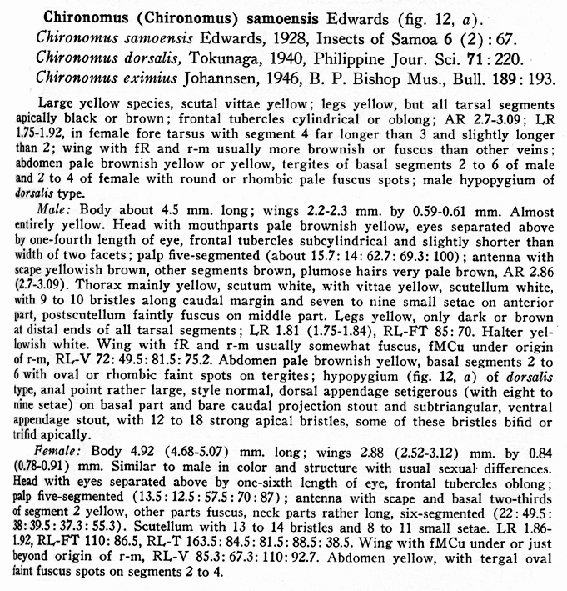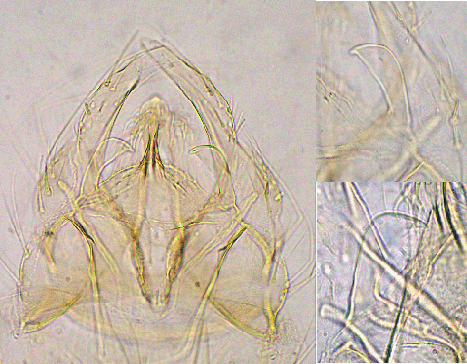Chironomus samoensis Edwards, 1928
Tokunaga's (1964) description of C. samoensis.
This seems the most reliable previous description of the adults.
Redescription based on specimens from Tutuila, American Samoa
C. samoensis: Male hypopygium (left) and superior volsella (right) (note the "beak" of lower figure)Males
AR about 2.4 - 2.9.
Frontal tubercles about 33 - 39 µm.
Palp proportions: 44 : 53 : 189 : 222 : 315
Wing length: 2.85 - 3.15 mm; wing width 0.30 - 0.67 mm.
VR about 0.95
Leg lengths (microns) and proportions as follows:
| | Fe | Ti | Ta1 | Ta2 | Ta3 | | PI | 1107 | 1000 | 1507 | 810 | 750 | | PII | 1170 | 1040 | 675 | 365 | 245 | | PIII | 1290 | 1245 | 1185 | 513 | 385 | | | Ta4 | Ta5 | LR | F/T | BR | | PI | 670 | 330 | 1.50-1.52 | 1.08-1.12 | 1.54-1.75 | | PII | 160 | 115 | 0.62-0.67 | 1.07-1.17 | | | PIII | 233 | 153 | 0.78-0.82 | 1.03-1.05 | | Abdomen pale, with darkening as described by Edward. Hypopygium similar to that of C. dorsalis, with the SV of the D type, similar to fig. e of Strenzke (1959), but sometimes with development of a "beak". The inferior volsella has mainly simple, curved setae, but a small number appear to have a small simple fork near the tip. About 4-6 setae on the 9th tergite near the base of the anal point. Female:
No females are available amongst the material, but some characters could be obtained from a pupa with a pharate female. An important character is the relative proportions of the fore leg, particularly the tarsi, as Tokunaga (1964) notes that the Ta4 of specimens he assigned to C. samoensis was unusually long. The approximate lengths of these segments were measured (in micron) as: Fe 900 ; Ti 750 ; Ta1 1020 ; Ta2 620 : Ta3 470 : Ta4 610 : Ta5 340; Ta4 about same length as Ta2, and about one third longer than Ta3.
Other characters:
Head - frontal tubercles - length 23µm, width 13 µm. Antennal segments (Ám) 144 : 109 : 116 : 106 : 215. About 24 clypeal setae.Thoracis setae: Acrostichal 14, dorsolateral 31, prealar 5, scutellar in two rows, ant. 14, post. 14. Diagnosis
Based on these descriptions, diagnostic features of the species are: Frontal tubercles relatively long; LR about 1.50 -1.52, fore Ta5 about one third of the length of the fore Ti, SV of the D-type, or "beaked"; in female fore Ta4 longer than Ta3 and about the same length as Ta2. In larva, antennal segment 3 relatively short, usually shorter than A5. In the polytene chromosomes, the nucleolus in arm G is median, and there is a further nucleolus about region 20 of arm F and usually a large puff in arm C. Found: Type locality - Apia, Western Samoa; Tonga.
American Samoa - Mapusaga and Faratogo, Tutuila.
Micronesia
Specimens from other areas (Australia, Japan,and India) are related species, but not C. samoensis[ Go to Index| Go to C. samoensis larva ] |

